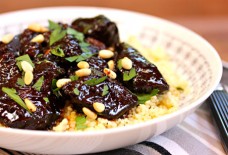Get Your Freekeh, the Ancient Arab Grain, On for Breakfast
By: Blanche Shaheen/Arab America Contributing Writer
Time and time again, nutritionists advocate eating the diet of our grandparents, basically a diet of unprocessed and whole foods. Nutritionists also advocate the Mediterranean diet in particular, which is recommended by the Dietary Guidelines for Americans to promote health and prevent chronic disease.
But what exactly made up the Arab ancestral Mediterranean diet? They ate whole foods consisting mainly of vegetables, fruits, nuts, seeds, legumes, whole grains, poultry, eggs, fish, yogurt, and plenty of extra virgin olive oil. Refined sugars and cheese were eaten in moderation and red meat was reserved for special occasions.
Out of all these food categories, the category of grains in the Middle East is starkly different than the grains eaten in the west. Bulgar wheat, farro, and freekeh contrast with the refined wheat, oats, and quinoa eaten in the west. Freekeh is one of the most intriguing yet virtually undiscovered grains that has yet to make an impression on the western palate.
The word freekeh comes from the word “farik” in Arabic, which means “to rub together.” The wheat is harvested while the grains are green and the seeds are still soft, Then the grains are piled and sundried, and carefully set on fire so that only the straw and chaff burn. Under these conditions, the high moisture content of the seeds prevents them from burning. The roasted wheat is then threshed and sun-dried to achieve a uniform flavor, texture, and color. This threshing or rubbing process of the grains gives this food its name. The result is a grain with a smoky flavor that you just cannot find in other grains.
Arabs in the Levant and their ancestors have been eating this ancient grain for many centuries however Freekeh is very popular in Palestine and Lebanon. Because the farmers harvest freekeh while the wheat is still young, the nutrients are more intact than wheat that is harvested when mature. Therefore freekeh has a unique nutritional profile superior to other grains.
This young green wheat packs in higher amounts of protein and fiber, as well as vitamins and minerals like calcium, magnesium, zinc and B vitamins–all important for bone and muscle health. Freekeh has double the iron of quinoa, three times the fiber of brown rice, and is 50% lower on the glycemic index than oats because it contains more insoluble fiber which is beneficial for healthy digestion. Whole grain freekeh is also packed with prebiotics, which are indigestible fibers that promote the growth of helpful bacteria in the gut microbiome.
Traditionally Palestinians and Lebanese eat freekeh with chicken or in a soup, however, I wanted to give this grain a modern and easy interpretation by preparing a freekeh porridge. In this recipe, you can cook freekeh in any kind of milk you choose, along with cinnamon or pumpkin pie spice for warm and comforting flavors in your morning bowl.
To ensure the minerals in the freekeh are more bioavailable, or readily absorbed by your body, pair the freekeh with good fats. One way to do that in this particular recipe is by adding coconut and almonds to the freekeh.
To see how easy it is to prepare this grain for breakfast, click on the video below!
Freekeh Porridge (serves 1 as a large portion or 2 smaller portions)
- 1/2 cup freekeh wheat
- 1 1/4 cup any kind of milk (I used walnut milk)
- 1/4 tsp cinnamon or pumpkin pie spice
- 2 tbsp date or maple syrup
- 1 tbsp chopped almonds
- 1-2 chopped Medjool dates
- 1 tbsp shredded coconut
- In a saucepan, heat the freekeh, plant milk, cinnamon, and date syrup and bring to a boil. Reduce heat and cover, cooking for about 25- 30 minutes. If the freekeh gets too dry add more milk and stir occasionally. Serve with chopped dates, coconut, and almonds on top. Serve immediately.
Blanche Shaheen is a journalist, host of the YouTube cooking show called Feast in the Middle East, and soon to be cookbook author of the “Feast in the Middle East” cookbook. She specializes in Arab cuisine of the Levant and beyond.
You can check out her cooking video tutorials and other recipes at https://www.youtube.com/user/blanchetv or her blog at https://feastinthemiddleeast.wordpress.com/
Click Here to Visit Our BLOG:
https://www.arabamerica.com/category/blog/



